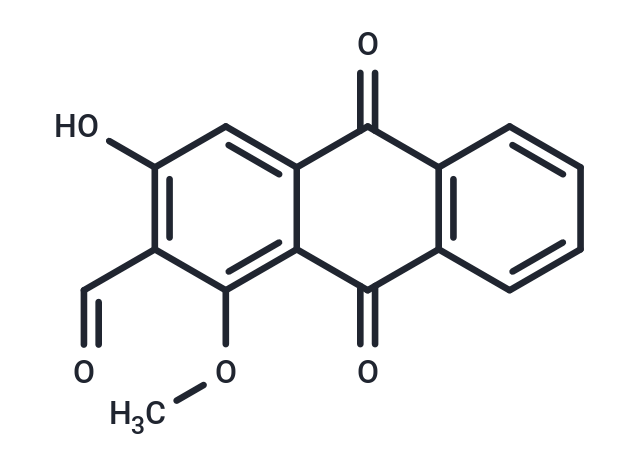Shopping Cart
- Remove All
 Your shopping cart is currently empty
Your shopping cart is currently empty

Damnacanthal is a natural anthraquinone compound with potential anticancer, anti-inflammatory, antioxidant, anti-malarial, and antiviral effects.Damnacanthal inhibits a variety of protein kinases such as LIMK1 (IC50=0.8 μM), LIMK2 (IC50=1.5 μM), and Lck (IC50=17 nM), and inhibits the growth of human hepatocellular carcinoma (SKHep-1) and human breast cancer (MCF-7) cells.

| Pack Size | Price | Availability | Quantity |
|---|---|---|---|
| 1 mg | $800 | Backorder |
| Description | Damnacanthal is a natural anthraquinone compound with potential anticancer, anti-inflammatory, antioxidant, anti-malarial, and antiviral effects.Damnacanthal inhibits a variety of protein kinases such as LIMK1 (IC50=0.8 μM), LIMK2 (IC50=1.5 μM), and Lck (IC50=17 nM), and inhibits the growth of human hepatocellular carcinoma (SKHep-1) and human breast cancer (MCF-7) cells. |
| Targets&IC50 | p56lck autophosphorylation:46 nM (IC50), Phosphorylation of exogenous substrates by p56lck:220 nM (IC50) |
| In vitro | Methods: Damnacanthal (100nM, 1, 10, 100μM, 1, 2, 4 days) was used to treat HCT-116 and SW480 cells to study its antiproliferative effects on human colorectal cancer cell types. Results: Treatment of HCT-116 cells with Damnacanthal resulted in a significant decrease in cell proliferation at 1 μM (P < 0.05), 10 μM (P < 0.01), and 100 μM (P < 0.01) after 4 days of treatment; SW480 cells also showed a significant decrease in cell proliferation at 10 μM (P < 0.05) and 100 μM (P < 0.001) after 4 days of treatment with Damnacanthal; Damnacanthal had a cytotoxic effect on colorectal cancer cells in both p53 wild-type (HCT-116) and p53 mutant (SW480) cells. Methods: HCT-116 cells were treated with Damnacanthal (1, 10, 50 μM) to determine its possible inhibitory effects on cell cycle progression and apoptosis, and caspase 3/7 activity was measured. Results: Treatment of HCT-116 cells with Damnacanthal (50 μM) resulted in a significant enrichment of cells in the S/G1 and G2/G1 phases. Treatment of HCT-116 cells with Damnacanthal (10 μM) significantly increased caspase 3/7 activity. [2] |
| In vivo | Damnacanthal (10-100 mg/kg, oral, 10-300 minutes) treatment of mice showed a dose-dependent and significant antinociceptive effect in the formalin test, and mice treated with Damnacanthal (100 mg/kg) significantly inhibited histamine-induced paw edema[3]. |
| Alias | Damnacantal |
| Molecular Weight | 282.25 |
| Formula | C16H10O5 |
| Cas No. | 477-84-9 |
| Smiles | O=CC1=C(O)C=C2C(=O)C=3C=CC=CC3C(=O)C2=C1OC |
| Relative Density. | 1.461g/cm3 |
| Storage | store at low temperature,keep away from direct sunlight,keep away from moisture | Powder: -20°C for 3 years | In solvent: -80°C for 1 year | Shipping with blue ice. | |||||||||||||||
| Solubility Information | DMSO: 2 mg/mL (7.09 mM), Sonication is recommended. | |||||||||||||||
Solution Preparation Table | ||||||||||||||||
DMSO
| ||||||||||||||||

Copyright © 2015-2025 TargetMol Chemicals Inc. All Rights Reserved.